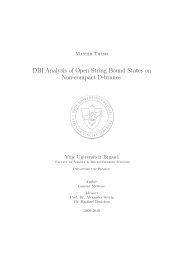Mismatch and synchronization: Influence of asymmetries in ... - CSIC
Mismatch and synchronization: Influence of asymmetries in ... - CSIC
Mismatch and synchronization: Influence of asymmetries in ... - CSIC
You also want an ePaper? Increase the reach of your titles
YUMPU automatically turns print PDFs into web optimized ePapers that Google loves.
MISMATCH AND SYNCHRONIZATION: INFLUENCE OF ... PHYSICAL REVIEW E 83, 056211 (2011)<strong>of</strong> this system. Instead a time-shifted synchronized solutionX 1 (t) = X 2 (t − τ) is possible [31]. To analyze the stability<strong>of</strong> this time-shifted identically synchronized solution, wedef<strong>in</strong>e the symmetric variable as S(t) = 1 2 [X 1(t + τ) +X 2 (t)] <strong>and</strong> the antisymmetric variable as A(t) = 1 2 [X 1(t +τ) − X 2 (t)]. The temporal evolution <strong>of</strong> these two variablesis then given byFIG. 6. Scheme <strong>of</strong> a bidirectional coupl<strong>in</strong>g setup with a delaymismatch <strong>of</strong> the self-feedback. The distances are given <strong>in</strong> time for aone-way trip. Both self-feedback strengths have the value L <strong>and</strong> thecoupl<strong>in</strong>g strengths both equal K.When l<strong>in</strong>eariz<strong>in</strong>g around A(t) = 0, we f<strong>in</strong>d that the l<strong>in</strong>earstability <strong>of</strong> the zero-lag synchronized solution <strong>in</strong> an openloopreceiver (ɛ = 0) is the same as the setup <strong>of</strong> two laserscoupled through a semitransparent mirror, without self- <strong>and</strong>cross-coupl<strong>in</strong>g mismatch (L = K). In contrast, <strong>in</strong> a closedloopreceiver, the stability <strong>of</strong> the <strong>synchronization</strong> manifoldis the same as <strong>in</strong> a mirror setup with a mismatch betweenself-coupl<strong>in</strong>g <strong>and</strong> cross-coupl<strong>in</strong>g.In chaotic communication, the open-loop configuration istraditionally preferred over the closed-loop scheme becauseit is more robust aga<strong>in</strong>st parameter mismatches <strong>and</strong> mucheasier to implement. In addition, the re<strong>synchronization</strong> time<strong>in</strong> the case <strong>of</strong> a sudden <strong>in</strong>terruption <strong>of</strong> the connection ismuch shorter (see Ref. [13] <strong>and</strong> references there<strong>in</strong>). It wasshown [37], however, that if the feedback delays are identical,the <strong>synchronization</strong> quality for the closed-loop rather thanfor the open-loop scheme is much higher. Also Ref. [49]showed that the performance <strong>of</strong> closed-loop receivers are lesssensible to detun<strong>in</strong>g between the emitter <strong>and</strong> receiver. Furthermore,several methods consider<strong>in</strong>g chaotic communicationshave been proposed that take advantage <strong>of</strong> specific properties<strong>of</strong> the closed-loop configuration [13,50].Ṡ = 1 2[f (S + A) + f (S − A)]+ 1 2 (L + K)C[S(t − τ 1) + S(t − τ 2 )]+ 1 2 (L + K)C[A(t − τ 1) − A(t − τ 2 )], (15)Ȧ = 1 [f (S + A) − f (S − A)]2+ 1 2 (L − K)C[S(t − τ 1) − S(t − τ 2 )]+ 1 2 (L − K)C[A(t − τ 1) + A(t − τ 2 )]. (16)It is clear that a (time-shifted) synchronized solution [A(t) =0] only exists if the self-coupl<strong>in</strong>g <strong>and</strong> cross-coupl<strong>in</strong>g are equal(L = K). This is <strong>in</strong> contrast to the case without delay mismatch(see Sec. II), where for any values <strong>of</strong> K <strong>and</strong> L, a synchronizedsolution exists, although it may be unstable. Thus for the casewith delay mismatch, we expect a strong dependence <strong>of</strong> the<strong>synchronization</strong> quality on the coupl<strong>in</strong>g mismatch L − K.For K = L, the synchronized solution corresponds to onelaser subject to two different feedbacks with the same strength12 (K + L) = K <strong>and</strong> respective delays τ 1 <strong>and</strong> τ 2 . A l<strong>in</strong>earstability analysis <strong>of</strong> Eq. (16), orthogonal to the <strong>synchronization</strong>manifold around A(t) = 0, then leads toδA(t) ˙ = Df (S)δA. (17)IV. RELAY CONFIGURATION WITH DELAY MISMATCHA. Synchronization propertiesWe come back to the case <strong>of</strong> bidirectionally coupled laserswith self-feedback. As discussed above, this coupl<strong>in</strong>g schemecan be realized experimentally with a semitransparent mirrorbetween the lasers. We now assume that the mirror is no longerpositioned <strong>in</strong> the perfect middle between the two lasers. Thelasers are hence subject to a different feedback delay τ 1,2 =τ ± τ, but they still experience the same coupl<strong>in</strong>g delayτ = 1 2 (τ 1 + τ 2 ), s<strong>in</strong>ce the distance between the lasers does notchange. A schematic representation <strong>of</strong> the setup is shown <strong>in</strong>Fig. 6.We can then model this system via the equationsX˙1 = f (X 1 ) + 1 2 LCX 1[t − (τ + τ)]+ 1 2 KCX 2(t − τ), (13)X˙2 = f (X 2 ) + 1 2 LCX 2[t − (τ − τ)]+ 1 2 KCX 1(t − τ) , (14)where we consider, without loss <strong>of</strong> generality, τ 0.The first laser then has a larger self-feedback delay(τ 1 = τ + τ) than the second laser (τ 2 = τ − τ). Zerolag<strong>synchronization</strong> X 1 (t) = X 2 (t) is no longer a solutionFIG. 7. (Color onl<strong>in</strong>e) Dynamics <strong>and</strong> correlation <strong>of</strong> two delaycoupledlasers with a delay mismatch <strong>of</strong> τ = 100 <strong>in</strong> the coherencecollapse regime. Upper panel: time series <strong>of</strong> laser output <strong>in</strong>tensitiesI 1 (t) [green (dark gray) l<strong>in</strong>e] <strong>and</strong> I 2 (t) (black l<strong>in</strong>e). The time tracesexhibit a time lag <strong>of</strong> τ. For demonstration purposes, the noisewas disregarded <strong>in</strong> this simulation. Lower panel: cross-correlationfunction <strong>of</strong> laser <strong>in</strong>tensities. The time shift <strong>of</strong> the maximumcorrelation peak equals the delay mismatch: t =−τ. Simulatedwith noise β = 10 −5 . Parameters for both simulations are τ = 2000,α = 4.0, p = 1.0, μ = 0.26, T = 200; all coupl<strong>in</strong>g strengths wereidentical L = K = 0.1.056211-5
















